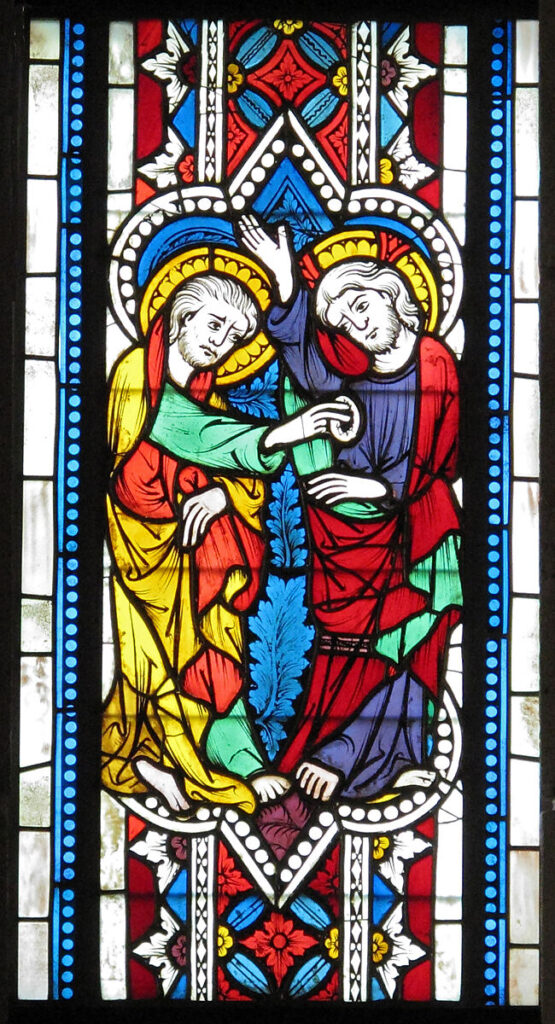Feast Day: July 3
Christianity reached India before it reached Ireland—about three centuries before. That fact surprised me when I first learned it. Ireland is a Catholic nation. Everyone knows that. India though—who would have guessed an ancient Christian community founded by one of the Twelve Apostles lives there? Yet the St. Thomas Christians of southern India do exist.
It’s easy to think of Christianity as a European phenomenon. That’s wrong. It began in the Middle East and the largest, most sophisticated Christian communities could be found there in Egypt, Syria, and nearby regions until the rise of Islam. Now Christianity is languishing in Europe but exploding in parts of Africa and Asia. For better or worse, the world doesn’t stay still. Nothing on earth possesses an immunity to change, even the pilgrim Church. To find a stable foundation, we have to look elsewhere. St. Thomas isn’t a bad guide.

Beyond Doubting Thomas
In my family, if you make one little mistake that other people find amusing, you hear about it for years. It literally took me decades to live down attempting to move ahead a couple extra spaces when playing Candyland at the age of four. St. Thomas the Apostle has been trying to live down one moment of skepticism for two thousand years. All that most people remember of him is “Doubting Thomas,” the apostle who wasn’t present in the upper room when Jesus first appeared to the apostles and who refused to believe his companions unless he could touch Jesus’ wounded and resurrected body himself: “Unless I see the mark of the nails in his hands and put my finger into the nail marks and put my hand into his side, I will not believe” (John 20:25). His name has become a byword for undue skepticism.
We know very little about Thomas’ life, but we can say that Thomas was not a man weak in faith. Jesus chose him from among his other Jewish followers to join his inner circle. When Jesus started his journey to Jerusalem and death, Thomas was the apostle who encouraged the other disciples to risk the danger: “Let us also go to die with him” (John 11:16). The fact he was absent in the upper room when Jesus first appeared says something: the other apostles hid themselves away, even after discovering Jesus’ empty tomb, but Thomas risked going out. When he heard Jesus had appeared, he focused immediately on the question of Jesus’ wounds. Thomas understood suffering and death as the path to resurrection.
That is perhaps how Thomas became the first disciple to proclaim Jesus’ divinity without qualification. Even Peter’s confession of Jesus as “the Messiah, the Son of the living God” (Mt 16:16) could be (and has been) interpreted as a title given to a mere man chosen by God. When Thomas saw Jesus resurrected with his wounds, he said, “My Lord and my God!” (John 20:28). On the other end of loving sacrifice, Thomas recognized a divinity that death could not touch.
That faith in Jesus eventually led all the apostles except John to martyrs’ deaths as they preached the Gospel. They slowly worked outwards from Jerusalem. Peter went to Antioch, then Rome. Thomas, according to widespread ancient tradition, went east following trade routes through the Middle East and then down to Kerala, the southern tip of India. There he founded seven churches before dying in service to Christ. These churches exist to this day (some in communion with Rome and some not). They are known as both Nazrani (followers of Jesus of Nazareth) and St. Thomas Christians.


Building a Lasting Palace
There is no historical doubt that Christianity came early to Kerala, an important trade hub connected to the Roman world with a Jewish community. We are much less certain about the details of Thomas’ missionary work. He attracted legends, especially among heretical communities who claimed, for example, that he was a twin of Jesus who taught secret knowledge that revealed the “true meaning” of Jesus’ public words (“Thomas” literally means “twin” in Greek). No historian believes that.
There is one story from these dubious Acts of Thomas that I like and may contain a germ of truth. At least the story’s antagonist, King Gondophernes, seems to have been a historical person since archaeologists have found coins in northwestern India from Thomas’ time with the similar name Guduphara on them. According to this tale, Thomas had been kidnapped and sold as a skilled slave trained in carpentry. Gondophernes, eager to bring the glory of the Roman empire into his own lands, purchased Thomas.
He questioned Thomas closely asking, “Can you build me a mansion worthy of one of the great men of Rome?”
Thomas replied, “I can do more than that, O King. I can build you a palace that will excite the envy of all Roman emperors throughout the ages.”
The excited Indian king immediately agreed and ordered the treasury to provide Thomas with whatever funds he needed. After a few weeks, he asked Thomas to see his progress. Thomas agreed and the king went out with his retinue through the streets of the town towards the construction site. To Gondophernes’ horror, Thomas stopped every block to give some of the construction money to cripples and beggars while blessing them in Jesus’ name. When they arrived at the site designated for the palace, only bare dirt greeted his eyes.
In fury, Gondophernes turned to Thomas. “You have cheated me! Where is my palace?”
Thomas calmly said, “But, O King, you saw me building it. Every coin I give to the poor in Jesus’ name lays a brick in your mansion in heaven. The palaces of the emperors will fall into ruin but the palace I build for you will stand in glory for all eternity as your home. As Jesus said, ‘store up treasures in heaven, where neither moth nor decay destroys, nor thieves break in and steal. For where your treasure is, there also will your heart be’ (Mt 6:20-21).”
That’s how Thomas got thrown in jail and almost killed. This time God miraculously freed Thomas from prison and then gave Gondophernes the grace of conversion. So Thomas continued on to Kerala where he continued preaching until his martyrdom.
Where Neither Moth nor Decay Destroys
Almsgiving builds our homes in heaven. Many saints and Fathers of the Church have said that. Nothing on earth lasts forever. Thomas knew that. Based on the few words from him that the Gospels record, Thomas may have understood better than any other apostle that Jesus’ mission in the world would lead to suffering and death—but with God something more is possible after that: Resurrection.
Christianity is about losing your life to gain it back eternally. We’re meant for something so much better than the inevitable decay of this world. That’s not to say that we should give up building something good here below, but we shouldn’t deceive ourselves into thinking it will last. What will last is our souls and those of the people whose lives we touch. The charity we give and our good works can, through God’s gift, prepare us and our companions for eternal happiness. Jesus transforms a temporary good into an everlasting good when we sacrifice for others. The Christian mystery of death and resurrection plays out in that way in our daily choices.
When I think of St. Thomas, I ask myself: Am I ready to sacrifice for others? Do I have faith enough in Jesus’ resurrection to put my hope in an unseen reward? Can I fearlessly love others so as to help them to heaven while helping also here below? Do I have the faith to believe that, even though I can’t fix all the problems I see around me, every little act of love I do helps build something eternal?
St. Thomas the Apostle, pray for me.
If you have a response, thoughts, or questions, please comment at the bottom of the page. Consider subscribing below to get weekly email notifications about new reflections and other news.



Very interesting. I now feel a much greater appreciation of St Thomas. Thank you Dr Eric.
Thanks!
In the Apocryphal Acts of St. Thomas the apostle and supported by the testimony of Eusebius and others, connects the Apostle St. Thomas with the valley of the Indus.
Gundaphorus had a long reign, from A.D. 21 to A.D. 60, and he ruled over the districts of Arachosia, the lower Indus, Herat, and Peshawur. He was a great ruler, like great rulers, he immortalized himself in stone. He was a mighty builder, and his buildings were artistically adorned.
Andrapolis, a royal city.” The Syrian trade with India went overland as far as the head of the Persian Gulf, and thence by sea to the mouth of the Indus. Andrapolis means the “city of the man,” and Purushapura, the modern Peshawar, has the same meaning. Purushapura was actually the royal city of Gundaphorus.
Gondaphares was the founder of Indo-Parthian or Phalava dynasty and it ruled from 19 BCE to 225 CE. They ruled and area covering parts of Eastern Iran, Afghanistan North West Regions of India comprising of Gandhara, Sindh and Western Punjab. Gondaphares belonged to the Royal House of SUREN, highest of the FIVE premiere families.
Around 19 – 20 CE He defeated SAKAS and thus extended his kingdom adding Sakasthan (Land of Sakas – Northern Baluchistan) Sindh and from Kabul Valley to Mathura.
At this time King Ghondapares made Taxila as his Capital.
Connection of King Gondaphares and Bible. 3rd CE Aramic text from Syria ” Acts of St. Thomas”, mentions one name GUNDAPHAR in whose court St. Thomas arrived it is believed that GONDAPHARES is the Greek version of GUNDAPHAR which was translated as GASTAPHAR in Armenian Language and later in CASPAR in western languages.
According to Bible CASPAR (Ghondaphares) the King of India was one of the three MAGI or WISE MEN of the east who visited Jesus after his birth with gifts.
HISTORIA TRIUM REGUM (History of Three Kings by John of Heildsheim 1364-1375) the name of King Caspar’s kingdom has been mentioned as ERGISILLA, ERGISILLA also finds mention on the GLOBE made in Nurmberg by German Cartographer Martin Behaim 1492. The Globe was is inscribed with words ERGISILLA BRAGMANNI (Ergisilla of the Brahmans). Explanatory treaties accompanying the Globe mentions ” Region of Ergisilla, in which there are Brahmans, there Caspar the Magus held the Dominion”. Ergisilla is distorted from of Taxila.
For centuries story of St. Thomas in the court of Gondaphares was considered a myth. From 1834 finding of the Coins minted by Gondapares shows that St. Thomas was contemporary of the King.
In Balakand of Valmiki Ramayana Sakas and Pahlavas ( Gondapres Dynasty) apper as allies of Rishi Vashitha. When King Vishwamitra wanted the Kamdhenu and dragged the cow… Rishi Vashistha ordered Kamdhenu Cow to create and army that would defeat the enemy. According to Ramayana Kamdhenu cow created Pahlavas ( Parthian) from her Udder. According to Manusmriti Pahlavas were kshatriyas.
Gandapheruda or double headed Eagle which found places in various kingdoms from India to Europe as symbol of Imperial power was created by the Parthian or Pahlavas. The Oldest know double headed Eagle is found on the Buddhist Stupa at Sirkap near Taxila.
I am Descendent of the Ghondapares (Indo-Parthian) lineage. 125 Generation.